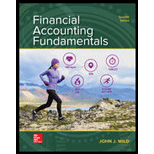
Concept explainers
Current assets: Current assets are assets which are expected to be converted into cash and cash equivalents within in the period of 1 year. Current assets can also be utilized to pay current liabilities of the company. Current asset include cash, short term investments, accounts receivables, inventories, prepaid assets and other current assets.
Long term investments: Long term investments are noncurrent assets which are not meant to be converted into cash and cash equivalent within in the period of 1 year. These are meant to benefit company for more than one year.
Plant assets: Also referred as fixed assets or long term assets, are assets with a useful life of more than one year and are generally subjected to depreciation. These are tangible in nature and add value to the business by generating revenues and profits from production and selling of products services.
Intangible assets: Intangible assets are the non visible assets which generally have a beneficial life of more than one accounting period.
Current liabilities: Current liabilities are liabilities which are expected to be converted into cash and cash equivalents within in the period of 1 year. Current assets can also be utilized to pay current liabilities of the company. Current asset include cash, short term investments, accounts receivables, inventories, prepaid assets and other current assets.
Long term liabilities: Long term liabilities are liabilities which are not due to be discharged within a time frame of one year.
To identify: The relevant category of balance sheet for the given items.
Want to see the full answer?
Check out a sample textbook solution
Chapter 3 Solutions
FINANCIAL ACCT.FUND.(LOOSELEAF)
- The following information is available for Cooke Company for the current year: The gross margin is 40% of net sales. What is the cost of goods available for sale? a. 5840,000 b. 960,000 c. 1,200,000 d. 1,220,000arrow_forwardCalculate the gross and net profits (in $) and the two profit margins (as %s) for the given company. (Round profit margins to the nearest tenth of a percent.) Company Net Sales Cost ofGoods Sold GrossProfit OperatingExpenses Net Profit Gross ProfitMargin (%) Net ProfitMargin (%) an optometry store $327,735 $201,655 $ $83,921 $ % %arrow_forwardProfit Margin, Investment Turnover, and ROI Cash Company has income from operations of $55,704, invested assets of $211,000, and sales of $506,400. Use the DuPont formula to compute the return on investment. If required, round your answers to two decimal places. a. Profit margin b. Investment turnover c. Return on investmentarrow_forward
- Profitability Analysis Erin Enterprises reports the following information on its year-end income statement: Net Sales $200,000 Operating Expenses $40,000 Cost of Goods Sold 110,000 Other Income 25,000 Required Calculate Erin’s gross profit percentage and return on sales ratio.(Round answer to one decimal place.) Gross profit percentage = Answer Return on sales ratio = Answerarrow_forwardProfit Margin, Investment Turnover, and ROI Briggs Company has operating income of $108,955, invested assets of $283,000, and sales of $990,500. Use the DuPont formula to compute the return on investment. If required, round your answers to two decimal places. a. Profit margin % b. Investment turnover c. Return on investment %arrow_forwardA company has a profit margin of 10% and reports net sales of $4,000,000 and average total assets of $5,000,000. Calculate the company’s return on assets. a. 12.5%.b. 8.0%.c. 4.5%.d. 5.0%.arrow_forward
- Use the following information to compute profit margin for each separate company a through e. (Round your answers to 1 decimal place.) Company Net Income Net Sales Profit Margin (%) 24 5,640 $ 47,000 a. 92,026 418,300 C. 96.444 267,900 di 68,738 1,527,500 77,959 455,900 e Which of the five companies is the most profitable according to the profit margin ratio? O Company a O Company b O Company c O Company d O Companyearrow_forwardBriggs Company has operating income of $45,760, invested assets of $143,000, and sales of $457,600. Use the DuPont formula to compute the return on investment. If required, round your answers to two decimal places. a. Profit margin % b. Investment turnover c. Return on investment %arrow_forwardThe balance sheet of ATLF, Inc. reports total assets of $1,950,000 and $2,050,000 at the beginning and end of the year, respectively. Net income and sales for the year are $150,000 and $1,000,000, respectively. What is ATLF's profit margin? Select one: a. 10% Ob. 8% O c. 7.5% O d. 15% e. 12%arrow_forward
- Briggs Company has operating income of $36,000, invested assets of $180,000, and sales of $720,000. Use the DuPont formula to compute the return on investment. a. Profit margin %b. Investment turnover c. Return on investmentarrow_forwardMarino Company has provided the following information: Net sales, $480,000 Net income, $24,000 Average total assets, $200,000 What is Marino's net profit margin?arrow_forwardAssume the following sales data for a company: Current year $861,289 Preceding year 512,943 What is the percentage increase in sales from the preceding year to the current year? a.67.91% b.59.56% c.40.44% d.167.91%arrow_forward
 Intermediate Accounting: Reporting And AnalysisAccountingISBN:9781337788281Author:James M. Wahlen, Jefferson P. Jones, Donald PagachPublisher:Cengage Learning
Intermediate Accounting: Reporting And AnalysisAccountingISBN:9781337788281Author:James M. Wahlen, Jefferson P. Jones, Donald PagachPublisher:Cengage Learning Managerial AccountingAccountingISBN:9781337912020Author:Carl Warren, Ph.d. Cma William B. TaylerPublisher:South-Western College Pub
Managerial AccountingAccountingISBN:9781337912020Author:Carl Warren, Ph.d. Cma William B. TaylerPublisher:South-Western College Pub Managerial Accounting: The Cornerstone of Busines...AccountingISBN:9781337115773Author:Maryanne M. Mowen, Don R. Hansen, Dan L. HeitgerPublisher:Cengage Learning
Managerial Accounting: The Cornerstone of Busines...AccountingISBN:9781337115773Author:Maryanne M. Mowen, Don R. Hansen, Dan L. HeitgerPublisher:Cengage Learning Financial And Managerial AccountingAccountingISBN:9781337902663Author:WARREN, Carl S.Publisher:Cengage Learning,
Financial And Managerial AccountingAccountingISBN:9781337902663Author:WARREN, Carl S.Publisher:Cengage Learning,



